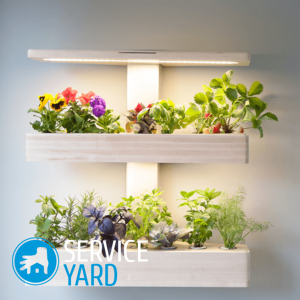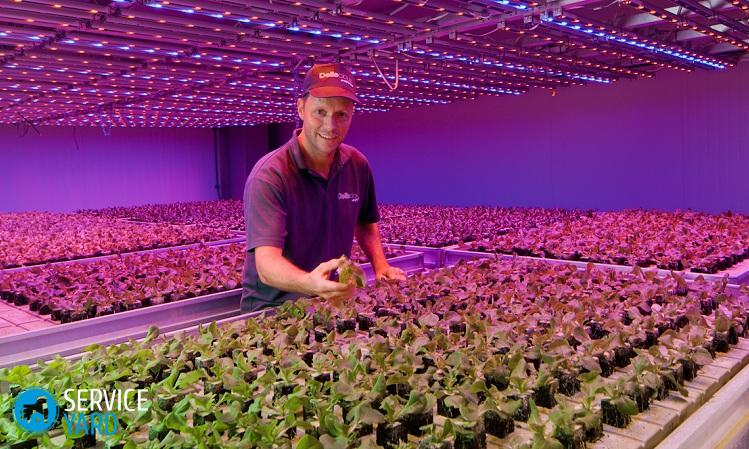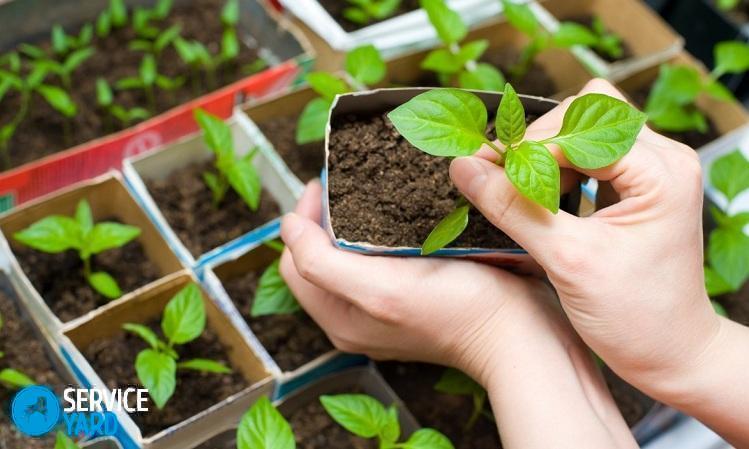Lamps for seedlings - how to choose?

The process of growing seedlings of many garden crops begins in the winter. When the first shoots appear and when young plants are dived into a separate container, it is very important to equip the lighting. Natural sunlight is clearly not enough, because winter daylight hours are short, and there are many cloudy days. In such a situation, additional illumination with the help of special devices used for growing seedlings is necessary. Modern technologies help summer residents make the best choice for themselves. On sale there is a wide range of effective and high-quality devices used for growing young plants. Let's talk about what are lamps for seedlings, how to choose the option you need, how to navigate in a huge number of offers from different companies.
to contents ↑Do I need additional lighting in principle?
First of all, let's talk a little about the general advantages of artificial lighting:
- Artificial insolation realistically mimics sunlight. A seedling develops as it would in natural sunlight.
- “Correct” lighting, as close as possible to natural, contributes to the development of plants without interruptions and any deviations.
Sometimes summer residents are interested in: is it possible to do without lamps? According to experts, it is undesirable to grow seedlings without artificial lighting. Plants are stretched, the leaves are pale and weak. Naturally, one cannot count on large yields in this case. Practice shows that for some vegetable crops (black onion, late varieties of pepper, celery), garden flowers (cloves, petunia, begonia), the use of artificial insolation is an objective necessity.
to contents ↑Which lamp is preferable?
Consider the main types of devices that are used for artificial insolation.
Important! Conventional incandescent lamps cannot be used for illumination. True, some summer residents practice this method of insolation, combining incandescent lamps with other types of lighting, but it is ineffective: energy costs are too large, and incandescent lamps emit a lot of heat.
Here are the most effective types of fixtures used for growing plants.
- LED light.
- Luminescent.
- Sodium.
- Energy saving.
- Induction.
LED light sources for seedlings
Today it is not difficult to purchase them.
Important! Scientists have proved that different colors of the spectrum have different effects on metabolic processes in plants. A well-defined range provides a realistic simulation of sunlight.
The main colors that influence the development of plants are red and blue, with wavelengths:
- for red - 660 nm;
- for blue - 460 nm.
Important! In order for seedlings to develop better, it is advisable to buy certified lamps. These devices are purchased only in specialized stores where appropriate documents can be requested.
According to experts, this is the most progressive method. By combining different LEDs, you can adjust the spectrum for any crop. The yield indicators in this case increase significantly.
Fluorescent
This is one of the most affordable methods. Such a source serves for a long time, it is not difficult to replace it.In shape, such a lamp resembles a glass tube, the walls of which are covered with a phosphor - a luminous composition based on phosphorus. It is this composition that contributes to the conversion of energy into light.
Inside the tube is filled with an inert gas argon and a small amount of mercury. This is the main disadvantage of fluorescent lamps. When disposing of, the fluorescent lamp must not be opened or disassembled. Such products are to be sent to specialized processing enterprises. This must be considered before choosing fluorescent lamps for seedlings.
Pros:
- A positive point for plants is that the main part of the range of fluorescent lamps is the ultraviolet radiation that plants need.
- Another advantage of this type of fixtures is compactness. For the illumination of plants, mainly short and medium lamps are used. They can be placed under the ceiling, while they occupy the very minimum of space.
Important! It is advantageous to use fluorescent sources in greenhouses and greenhouses when growing vegetables for sale. A small lamp covers large areas, providing sprouts with the light they need.
Sodium lamps
This option is considered the most environmentally friendly. Lamps of this type are used when growing plants both on an industrial scale and in summer cottages.
How to choose such lamps for seedlings:
- The best choice for additional seedlings - lamps with a power of up to 100 watts.
- The main range of such lamps is red-orange. It is needed by plants during flowering and during fruit setting.
Lamps are very economical and durable.

Energy saving
Their main advantage is that by combining several lamps, you can create optimal conditions for the plant to develop. So, it is possible to create such varieties of light:
- Day. Ultraviolet illumination is necessary for the plant throughout the growing season. It is also used for seedlings at various times of the day.
- Warm (red). Especially relevant during the flowering period.
- Cold (blue). This part of the spectrum is necessary for young plants during seed germination and the appearance of the first seedlings.
Important! To maximize the efficiency of illumination, experts recommend placing lighting fixtures perpendicular to the vessels with seedlings.
Induction
This is one of the most innovative backlighting technologies, with low energy costs. The light source is plasma (magnetic radiation ionizes the gas). Such devices emit two colors of the spectrum, the most popular among plants - red and blue. They are also known as bispectral, or bicolor.
to contents ↑Important! Such a lamp at the same time serves as a source of heat for plants, as it is heated to 700 degrees.
How to place the sources for the illumination of plants?
Which lamps are better for highlighting seedlings - figured out. Now about the mutual placement of light sources and plants. Lighting devices must be placed in such a way that they cannot harm the plants. Consider the basic principles of their mutual placement:
- You should not place lamps on the side of the plants, as this can provoke the curvature of the stems of seedlings (after all, all plants are drawn to light).
- Do not remove the lamps too far from seedlings. If the seedlings have pale leaves and too long stems, you need to reduce the removal of the lighting device by about a third.
- Similarly to the previous rule, it is not necessary to bring the lighting device closer to the plant too close, as it can cause burns.
- The optimal choice of illumination depends on the type of plants and is determined experimentally. If the seedlings look healthy, then the lighting method and lamp placement are chosen correctly.
Now - a brief overview of the different types of backlighting.
to contents ↑Seedling lamps - an overview of popular models
So which lamps are best for seedlings? Consider first the most popular manufacturing companies?
- Philips
- STARLIGHT.
- Bellson
- Electrum.
Sodium
“Reflax” is the best solution among sodium discharge devices. The lamp not only helps plants grow normally, but also does not irritate the eyes. It can be used for growing seedlings at home. The only negative is that a special pulse device is needed to start the device.
Important! If we talk about sodium lamps, then a good option is a device from Osram called Plantastar 600W (base E40).
Fluorescent
Fluora is one of the best sources of the luminescent type. The number of devices per square meter of premises is 2. Flora lamps are popular among summer residents, reviews are only positive.
Important! A good option for a fluorescent lamp is the PAULMANN product line. Their power is 40-100 watts. They heat up weakly, their working life is quite long.
findings
If we analyze customer reviews, we can draw such conclusions about which lamps are better for growing seedlings:
- The cheapest option is OSRAM L 36 W / 765 Daylight, a device with a 40-watt fluorescent lamp.
- OSRAM L 18 W / 77 FLUORA - 18 watts (60 cm), the optimum ratio of quality and value.
- The best option for those who think how to choose an LED lamp for seedlings is the LED Grow Light phytolamp.
Stock footage
Choose, experiment, try for the future harvest!
- How to choose a vacuum cleaner taking into account the characteristics of the house and coatings?
- What to look for when choosing a water delivery
- How to quickly create comfort at home - tips for housewives
- How to choose the perfect TV - useful tips
- What to look for when choosing blinds
- What should be running shoes?
- What useful things can you buy in a hardware store
- Iphone 11 pro max review
- Than iPhone is better than Android smartphones




